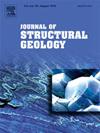Crystal preferred orientation of lawsonite and glaucophane in lawsonite blueschist deformed in general shear
IF 2.9
2区 地球科学
Q2 GEOSCIENCES, MULTIDISCIPLINARY
引用次数: 0
Abstract
The crystal preferred orientations (CPOs) of lawsonite and glaucophane in lawsonite blueschist reflect deformation processes in the cold subducting oceanic crust and are crucial for understanding subduction zone dynamics. However, the dominant CPOs of lawsonite and glaucophane and their formation mechanisms in cold subduction zones remain uncertain. We conducted deformation experiments on lawsonite blueschist in general shear at high pressures (1.0–2.5 GPa) and low temperatures (230–400 °C), with varying shear strains (γ = 1.1–4.0). Two types of lawsonite CPOs were found with increasing shear strain: Type-A, where the [010] axis is subparallel to the shear direction, and Type-B, where the [100] axis is subparallel to the shear direction, with the [001] axes subnormal to the shear plane for both types. Additionally, a single type of glaucophane CPO was observed regardless of the magnitude of shear strain, characterized by the [001] axes aligned subparallel to the shear direction and the [100] axes aligned subnormal to the shear plane. This pattern is consistent with those most commonly reported in previous studies. Cataclastic flow was observed in the lawsonite blueschist samples, as indicated by intragranular and shear fractures. In addition, the observation of weak intracrystalline deformation of lawsonite and glaucophane with a minor dislocation suggests that rigid-body rotation with a minor dislocation activity may be a mechanism underlying the CPO formation in these minerals. Our findings highlight that the magnitude of shear strain significantly influences the development of lawsonite CPOs in cold subduction zones.
一般剪切变形的铁榴石蓝片岩中铁榴石和蓝榴石的晶体择优取向
铁榴辉石蓝片岩中铁榴辉石和蓝榴辉石的晶体优选取向(CPOs)反映了冷俯冲洋壳的变形过程,对了解俯冲带动力学具有重要意义。然而,在冷俯冲带中,钙辉石和蓝帘石的主导成分及其形成机制仍不确定。在高压(1.0 ~ 2.5 GPa)和低温(230 ~ 400℃)条件下,对不同剪切应变(γ = 1.1 ~ 4.0)下的lawsonite蓝片岩进行了变形实验。发现两种类型的lawsonite CPOs剪切应变增加:a型[010]轴与剪切方向近平行,b型[100]轴与剪切方向近平行,两种类型的[001]轴均与剪切平面近法向。此外,无论剪切应变的大小如何,都观察到单一类型的glaucopane CPO,其特征是[001]轴与剪切方向近平行,[100]轴与剪切面近法向。这种模式与以前的研究中最常见的报道一致。从粒内断裂和剪切断裂可以看出,碎裂流存在于蓝片岩样品中。此外,钙辉石和蓝绢石的微小位错的弱晶内变形表明,具有微小位错活动的刚体旋转可能是这些矿物中CPO形成的机制。研究结果表明,剪切应变的大小显著影响了冷俯冲带中钙镁石cpo的发育。
本文章由计算机程序翻译,如有差异,请以英文原文为准。
求助全文
约1分钟内获得全文
求助全文
来源期刊

Journal of Structural Geology
地学-地球科学综合
CiteScore
6.00
自引率
19.40%
发文量
192
审稿时长
15.7 weeks
期刊介绍:
The Journal of Structural Geology publishes process-oriented investigations about structural geology using appropriate combinations of analog and digital field data, seismic reflection data, satellite-derived data, geometric analysis, kinematic analysis, laboratory experiments, computer visualizations, and analogue or numerical modelling on all scales. Contributions are encouraged to draw perspectives from rheology, rock mechanics, geophysics,metamorphism, sedimentology, petroleum geology, economic geology, geodynamics, planetary geology, tectonics and neotectonics to provide a more powerful understanding of deformation processes and systems. Given the visual nature of the discipline, supplementary materials that portray the data and analysis in 3-D or quasi 3-D manners, including the use of videos, and/or graphical abstracts can significantly strengthen the impact of contributions.
 求助内容:
求助内容: 应助结果提醒方式:
应助结果提醒方式:


